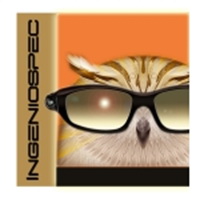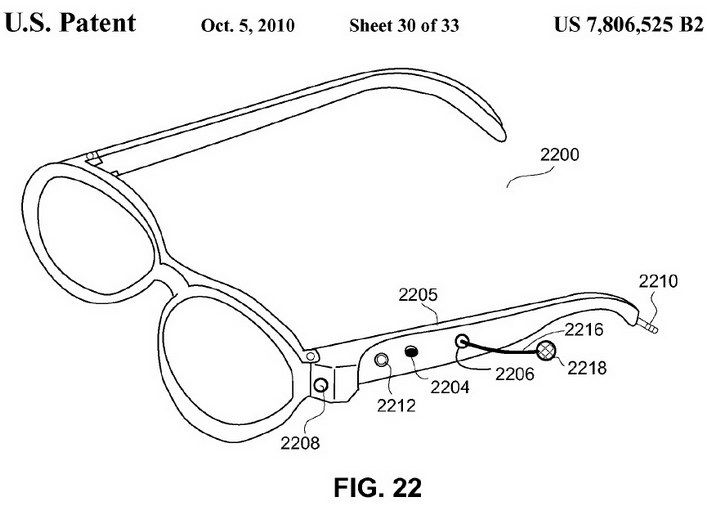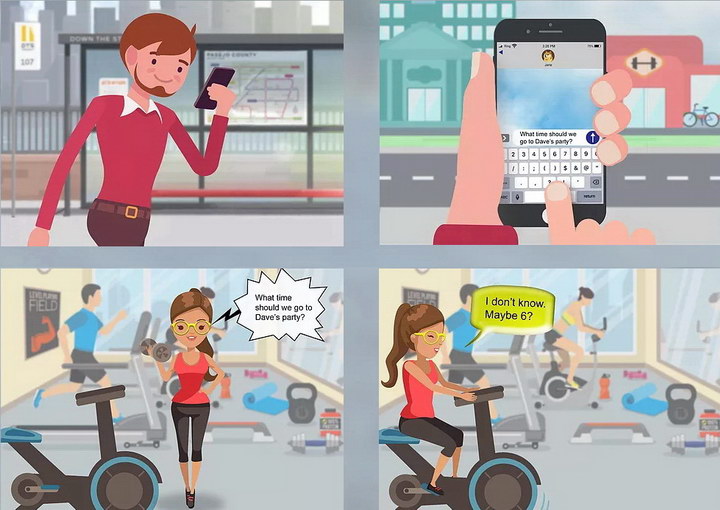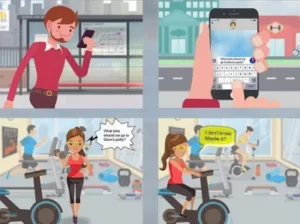IngenioSpec and its affiliate IpVenture has a large patent portfolio for eyewear for every purpose. One thing their portfolio does not seem to cover is near-eye displays for use on that eyewear. However, it is hard to imagine an application of a glasses-mounted near-eye display that would not require one or more of the IngenioSpec technologies.

 IngenioSpec Logo (Credit: IngenioSpec)
IngenioSpec Logo (Credit: IngenioSpec)
For example, if you want to put a camera in your AR eyewear, they have a patent for that: US 7,806,525 titled “Eyeglasses Having a Camera” and issued October 5, 2010, three years before Google popularized the idea with Google Glass. According to Peter Tong, co-inventor of over 100 US patents and co-founder of both IngenioSpec and IpVenture, “Google has not sought a license before their introduction.” He added that they do not currently have a license, either.
 Figure 22 from US 7,806,525 assigned to IpVenture, Inc. Item 2208 is the camera embedded in the eyewear. 2218 is an earbud to bring audio to the user.
Figure 22 from US 7,806,525 assigned to IpVenture, Inc. Item 2208 is the camera embedded in the eyewear. 2218 is an earbud to bring audio to the user.
This patent has 30 claims associated with it. The broadest claim is Claim 1 which reads:
- A pair of glasses for a user, comprising:
an eyeglass frame having at least first and second temples;
a digital camera at least partially embedded in the first temple, the digital camera being configured to acquire at least an individual picture;
a user input device configured to receive a user input to activate acquisition of the individual picture by said camera;
a data storage device configured to store one or more in individual pictures acquired by said camera; and
a microphone configured to acquire audio input to be recorded to said data storage device,
wherein the acquired audio input stored in said data storage device is associated with the individual picture acquired by said camera and stored in said data storage device.
 SnapSpec sunglasses with an embedded camera from IngenioSpec. (Credit: IngenioSpec)
SnapSpec sunglasses with an embedded camera from IngenioSpec. (Credit: IngenioSpec)
The one consumer product sold by IngenioSpec is the SnapSpec glasses and is based on this patent. These glasses include an 8MPixel camera with a 75° field of view (visible between the two lenses) that will take still pictures or record 1080P 30FPS or 720p 60FPS video. The images are stored on a microSD card or transmitted using Wi-Fi to an iOS or Android device. These glasses are also covered by another IngenioSpec patent, US 8,434,863 B2 titled “Eyeglasses With A Printed Circuit Board” and issued May 7, 2013. Presumably, these are manufactured for IngenioSpec by their publicly announced partner Contour Optik, although that is not made explicit by the company. Presumably, most of the company’s business is licensing its patent portfolio.
These two patents aren’t the only eyewear patents assigned to IngenioSpec or its affiliated IP firm IpVenture. 35 eyewear patents are listed on the IngenioSpec website, including links to PDF copies of each patent. The most recent of these patents is US 10,359,311 issued July 23, 2019 and titled “Eyewear With Radiation Detection System”. While detecting the radiation from a nuclear apocalypse would be covered by the broad claims of this patent, probably the most likely application of this technology would be detecting and monitoring UV radiation by sunglasses worn to the beach with the intent of avoiding a sunburn.
Note that while IngenioSpec and IpVenture are closely affiliated and have the same founders, they are not the same company. IpVenture is a full-service Intellectual Property (IP) firm and serves other inventors besides the ones at IngenioSpec. For example, six patents associated with hands-free text messaging are listed on the IpVenture website but are not listed on the IngenioSpec website.
IngenioSpec suggests multiple possible applications for its eyewear technology, including common ones suggested by others such as outdoor activity eyewear, infotainment, and other mobile applications. In addition to these applications, the company says its patented technology can improve the structural design of eyewear for any application by making it lighter, stronger and cheaper as well as more functional. None of the patents listed by IngenioSpec or IpVenture deal directly with head-mounted displays although some of the technology discussed would make it easier to connect an HMD to its information source.
IngenioSpec also suggests eyewear for the elderly and says:
“IngenioSpec imagines inventive ways technology can benefit elderly users who want to remain independent. Our patented smart eyewear empowers and guides the elderly through routine obstacles, from maintaining a daily schedule to addressing critical needs in the event of an emergency.?
“As the elderly population continues to grow, technologies for aging will become crucial for ensuring seniors’ well-being. Existing devices and services attempt to address some of these needs, but can be conspicuous and unwieldy. IngenioSpec technology envisions a discreet, stylish product combining the ultimate in ease-of-use with compact, lightweight electronics in an item many seniors already use every day: eyewear.”
 Fall detection using IngenioSpec patents. (Credit: IngenioSpec)
Fall detection using IngenioSpec patents. (Credit: IngenioSpec)
The eyewear could be used to connect the elderly with either a digital or human assistant able to answer questions and aid the wearer. For example, a digital assistant could remind the wearer to drink, eat and take medicine on schedule. A motion detector in the eyewear could also determine if the wearer has been stationary too long and suggest they get up and walk around. The motion system could also detect falls and if the wearer has gotten up after the fall. If, after a fall, there is no additional motion, the system could alert a caregiver or even 911 that there is a problem. A few of these functions are already incorporated in emergency alert bracelets often worn by the elderly, but eyewear with two-way communications abilities would significantly improve the functionality. Another thing IngenioSpec suggests could be built into eyewear is hearing assistance, with microphones to pick up ambient sounds and amplify them for the wearer. These amplified sounds could then be delivered to the wearer either by earbuds or bone conduction.
IpVenture adds some suggested applications of its own. For example, they say that use of one or more of their patents allows text messages to be sent and received by AR/VR eyewear users even while the wearer is fully engaged in AR/VR activities.
 Use of patents controlled by IpVenture allows the hands-free sending and receiving of text messages on AR eyewear. (Credit: IpVenture)
Use of patents controlled by IpVenture allows the hands-free sending and receiving of text messages on AR eyewear. (Credit: IpVenture)
For example, if a person wants to send a friend a text message while she is at the gym and is wearing AR eyewear to monitor her heart rate, a text to voice converter in the eyewear could read the text to her without interrupting what is displayed on the AR display. She could then respond verbally, both to control the system and send the message using a voice to text converter.
In fact, taking this one step farther, it would be possible to have at least basic AR functionality in glasses without a near-to-eye display. Instead of showing augmented reality information on the display, the text to voice converter could just read the information to the wearer. Driving directions, for example, could be a verbal “Turn left in 100 feet” rather than a graphical display of a left turning arrow. This not only avoids the visual distraction of the driver but would significantly reduce the cost, size, weight and power consumption of the head-mounted device (HMD).
Suggesting that HMDs without displays could provide major functionality for end-users could be seen as not really appropriate for a column titled “Display Daily.” On the other hand, see-through near-eye displays with enough resolution and image quality to be useful and small enough to be worn as an inconspicuous head-mounted display have actually proven to be extraordinarily difficult to design and build. Since most people carry a high-quality smartphone display in their pocket anyway, linking the HMD to the smartphone via Wi-Fi or other video-bandwidth connection would seem to make a lot of sense. Simple information like text messages, driving directions or heart rate could be passed on by voice. More complex information would appear on the smartphone screen.
Perhaps for industrial and commercial applications where hands-free is a requirement; low cost and comfort are secondary requirements; and avoiding the “geeky” look is not a requirement at all; an eyewear display may be required to meet the application’s needs. For a consumer system where low cost, light weight and avoidance of the “geeky” look are critical design factors for a successful product, perhaps voice control and voice delivery of information could become a viable HMD (device, not display) option. -Matthew Brennesholtz

